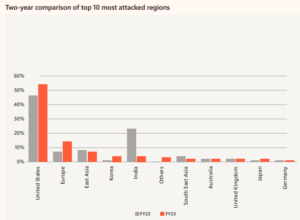In the ever-evolving world of cybersecurity, staying up to date with the latest trends and statistics is crucial. The Microsoft Digital Defence Report for 2023 sheds light on the shifting dynamics of cyber attacks worldwide. In this blog post, we’ll explore the key findings of the report, highlighting how India’s cyber threat landscape has transformed and examining the global cyber attack scenario.
The Changing Face of Cyber Attacks
In 2022, India was ranked second among countries with the highest number of cyber attacks. However, in 2023, we find India in fifth place, while Europe has surged to the second position, accounting for 14 percent of all cyber attacks. This significant shift highlights the fluid nature of cyber threats, with attackers constantly changing their targets and tactics.
United States Takes the Lead
The most notable revelation from the Microsoft report is the United States’ ascent to the top of the table for different forms of cyber attacks. American entities have become the primary targets for Distributed Denial-of-Service (DDoS) attacks, constituting a staggering 54 percent of all such attacks. But what exactly is a DDoS attack?
DDoS attacks are designed to overwhelm targeted devices, services, and networks with fake internet traffic, rendering them inaccessible or useless for genuine users. It’s a prevalent and disruptive form of cyber attack, and the United States now bears the brunt of it.
 India’s Remarkable Decrease
India’s Remarkable Decrease
In the 2022 report, India was responsible for approximately 25 percent of all reported cyber attacks. However, the 2023 report reveals a significant reduction, with India accounting for less than five percent of such attacks. This decline showcases India’s improving cyber defense strategies and emphasizes the need for robust cybersecurity measures to mitigate future threats.
Regional Priorities
In the Asia-Pacific region, India maintains its position as the third most targeted country by threat actors, following Korea and Taiwan. Ukraine stands out as the top European target, largely due to Russian state actors’ invasion-related operations. In the Middle East and North Africa, Israel remains the most targeted nation, courtesy of Iran’s extensive focus on the region.
The Asia-Pacific region witnesses North Korean and Chinese state actors, driving South Korea and Taiwan to become the first and second most targeted countries. This highlights the global nature of cyber threats and the need for international cooperation in tackling them.
Espionage and National Defense
The Microsoft report also sheds light on the espionage activities of various countries. Notably, North Korea shows a keen interest in spying on institutions and individuals studying North Korea itself. Additionally, they target the national defense industries of various countries. India accounts for seven percent of these attacks, while Russia tops the list, closely followed by the USA and Israel.
Conclusion
As we delve into the findings of the Microsoft Digital Defence Report for 2023, it becomes evident that the landscape of cyber attacks is in constant flux. The United States now leads the pack, DDoS attacks are on the rise, and India is making strides in reducing its vulnerability. Understanding these trends is essential for individuals and organizations to stay ahead in the ever-evolving world of cybersecurity. Stay tuned for more insights and updates on the ever-changing cyber threat landscape.
